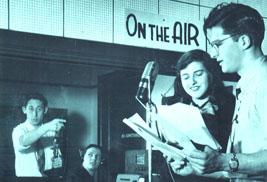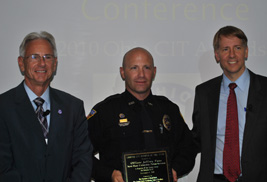Featured Article
Police Services Campus Officer Receives Ohio CIT Officer of the Year Award
Profiles of Excellence in Action:
Officer Jeff Futo received the 2010 Campus Crisis Intervention Team (CIT) Officer of the Year Award. CIT is a specialized training program that teaches officers skills to deescalate certain individuals in crisis situations.
Public Radio Stations and Universities Enjoy Long, Productive Shared History
Posted Sept. 27, 2010
The early days of college radio.
The history of radio may have started at the turn of the 20th century, but the evolution of public radio began with university-licensed radio stations like WKSU-FM, which celebrates its 60th year in October.
Many of the country's first radio stations grew up at colleges and universities, like Kent State, which wanted to experiment with FM frequencies to educate and entertain the public, according to National Public Radio (NPR).
Al Bartholet, WKSU-FM's executive director and general manager, who has been at the station for 30 years, says since its inception in 1950, WKSU-FM has continued as a trusted source of information and entertainment for its listeners.
He fondly relates his interpretation of the meaning of the station to its listeners.
"My best memories are always of meeting our listeners. Finding out what our station means to people is a very humbling experience," says Bartholet. He shared a favorite example: hearing from a soldier, who said that listening to the station online granted him some peace while serving in Iraq. "It's very touching to see and to make connections with our listeners. That's what I'll walk away with when I retire - the connections with the listeners."
In the late 1940s, Kent State experimented with its broadcasting capabilities when FM frequencies began commercial development. The Federal Communications Commission (FCC) allotted the lower end of the new FM band exclusively to noncommercial, educational stations, setting the stage for a major station expansion. This part of the radio dial is where most public stations are still found today, according to NPR.
In 1948, Kent State's radio workshops begin installing a 5-watt signal that was sent over wires to the residence halls. One year after the Kent State Board of Trustees filed an application for a 10-watt educational station in 1949, WKSU-FM was born on Oct. 2, 1950.
From a single-ring antenna mounted on a 50-foot pole attached to a chimney on the roof of Kent Hall, WKSU-FM officially begin a diverse mix of regularly scheduled programming five hours a day, five days a week during the academic year with a student on-air staff.
Since then WKSU-FM has become an NPR affiliate, increased its coverage area, moved into a new facility, and launched wksu.org to nationally stream live audio over the Internet.
Craig Beeby, executive director of University Station Alliance, a nonprofit organization that helps stations and university licensees interact in a cooperative and efficient state, says that universities were usually at the forefront of technologies, and those technologies easily transferred into experimental radio.
Hence, college radio became more frequent in the 1960s when the FCC began issuing licenses for 10-watt stations to further the development of the FMband."Channels 88 through 92 were set aside for noncommercial and educational use, which allowed students to have practicum experience and make mistakes with no one listening," Beeby explains.
Through this radio experimentation, it was discovered that the FM channels had better sound quality and range.
"Public radio and noncommercial evolved from universities," Beeby says. "Radio morphed into more news and music stations as FM channels gained an audience."
Beeby added that nearly two-thirds of stations today are licensed through universities. Because of universities' ability to provide quality resources to stations
"The majority of stations are still associated with universities," Beeby says. "Universities help provide different quality resources to stations. These stations also tend to be community orientated with education being a common thread with listeners. Oftentimes there is a public relations benefit for the university by having content related to the university."
University-licensed stations proved to be a cost-effective means of lifelong learning and often gain listeners' contributions and local business support.
"The rewards and returns to university are multifold versus the expense to a university. University-license stations provide an ongoing public service," Beeby says. "It's this kind of programming that has made WKSU-FM a lifelong learning resource, that's not available elsewhere."
"It is customized to fit Kent State. It expands campus boarders, making an intimate contact with listeners who have no other reason to be associated with the radio station. WKSU-FM has a very high profile as a top-quality station. It is well managed, and I wish them another 60 years of success"
Read e-Inside next week for more on the 60th anniversary of WKSU-FM.
By Erin C. Perkins
